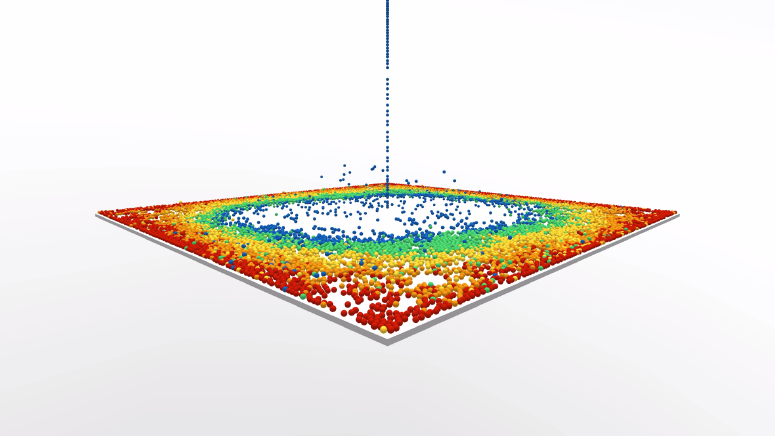Tobiaszimmer (talk | contribs) (→Code) |
Tobiaszimmer (talk | contribs) No edit summary |
||
| (6 intermediate revisions by the same user not shown) | |||
| Line 1: | Line 1: | ||
=='''Final Project'''== | =='''Final Project'''== | ||
==''' | =='''1^-300'''== | ||
[[File:10e-300_03.png|link=https://www.youtube.com/watch?v=gIvfwD4Jnv4|frameless|775px]] | [[File:10e-300_03.png|link=https://www.youtube.com/watch?v=gIvfwD4Jnv4|frameless|775px]] | ||
»1^–300« was created as an accompanying computer simulation for the show »20.000!« at ACC-Gallery Weimar, a collaborative exhibition organized by artist [http://lodewijkheylen.be/ Lodewjik Heylen], Martin Schneider and the students of the »Meandering through Space« class (Maud Canisius, Linda Anna-Sophia Dertinger, Rachel Smith, Tobias Zimmer). The gallery floor was filled with 20.000 ball pit balls, ordered by color before the opening and subsequently brought into chaos by entering visitors. The balls mix slowly, create patterns, formations and sequences. The original structure falls apart into visual chaos, resulting in a fluid stream of color. | |||
»1^-300«, as well as the other created digital simulations included in the exhibition, establish a theoretical parallel to the tangible installation and demonstrate both correlations and absurdities in the gap between the virtual and the analog. Dropping 20.000 balls onto a digital plane, one by one, in exactly the same position, will result in a perfectly balanced stack. However, the smallest perturbation — an offset of an enormously tiny magnitude (1^-300) — eventually has considerable impact and results in the collapse of the stack. | |||
'''[https://www.youtube.com/watch?v=gIvfwD4Jnv4 Click here to watch the video loop (07:21min)]''' — recommended | '''[https://www.youtube.com/watch?v=gIvfwD4Jnv4 Click here to watch the video loop (07:21min)]''' — recommended | ||
| Line 13: | Line 13: | ||
=='''Video Stills'''== | =='''Video Stills'''== | ||
<gallery mode="nolines"> | <gallery mode="nolines"> | ||
| Line 24: | Line 25: | ||
=='''Code'''== | =='''Code'''== | ||
»1^-300« was written in [https://threejs.org/ three.js], using the physics library [https://github.com/lo-th/Oimo.js/ oimo.js]. | |||
The video was rendered with [https://github.com/spite/ccapture.js/ CCapture.js], "a library to help capturing animations created with HTML5 canvas at a fixed framerate". | The video was rendered with [https://github.com/spite/ccapture.js/ CCapture.js], "a library to help capturing animations created with HTML5 canvas at a fixed framerate". | ||
Rendering was quite a challenge and took several hours, since the animation becomes slower with each dropped ball. Additionally, saving the output as batches of png files required some internal changes in the code of CCapture.js → https://github.com/spite/ccapture.js/issues/37 . The problem does not exist when exporting to webm format instead of png | Rendering was quite a challenge and took several hours, since the animation becomes slower with each dropped ball. Additionally, saving the output as batches of png files required some internal changes in the code of CCapture.js → [https://github.com/spite/ccapture.js/issues/37 github issue]. The problem does not exist when exporting to webm format instead of png and the quality is only a little worse. | ||
You can download the code [http://www.tobiaszimmer.net/ball_simulations/10-300.zip here]. | You can download the code [http://www.tobiaszimmer.net/ball_simulations/10-300.zip here]. | ||
Latest revision as of 13:42, 22 November 2018
Final Project
1^-300
»1^–300« was created as an accompanying computer simulation for the show »20.000!« at ACC-Gallery Weimar, a collaborative exhibition organized by artist Lodewjik Heylen, Martin Schneider and the students of the »Meandering through Space« class (Maud Canisius, Linda Anna-Sophia Dertinger, Rachel Smith, Tobias Zimmer). The gallery floor was filled with 20.000 ball pit balls, ordered by color before the opening and subsequently brought into chaos by entering visitors. The balls mix slowly, create patterns, formations and sequences. The original structure falls apart into visual chaos, resulting in a fluid stream of color.
»1^-300«, as well as the other created digital simulations included in the exhibition, establish a theoretical parallel to the tangible installation and demonstrate both correlations and absurdities in the gap between the virtual and the analog. Dropping 20.000 balls onto a digital plane, one by one, in exactly the same position, will result in a perfectly balanced stack. However, the smallest perturbation — an offset of an enormously tiny magnitude (1^-300) — eventually has considerable impact and results in the collapse of the stack.
Click here to watch the video loop (07:21min) — recommended
Video Stills
Code
»1^-300« was written in three.js, using the physics library oimo.js.
The video was rendered with CCapture.js, "a library to help capturing animations created with HTML5 canvas at a fixed framerate". Rendering was quite a challenge and took several hours, since the animation becomes slower with each dropped ball. Additionally, saving the output as batches of png files required some internal changes in the code of CCapture.js → github issue. The problem does not exist when exporting to webm format instead of png and the quality is only a little worse.
You can download the code here.






